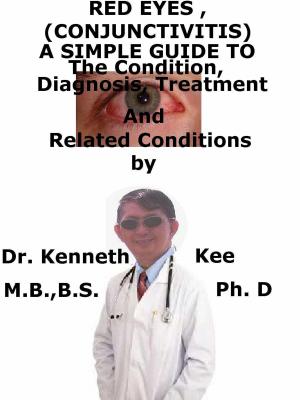Pemphigus, A Simple Guide To The Condition, Diagnosis, Treatment And Related Conditions
Nonfiction, Health & Well Being, Health, Ailments & Diseases, Skin, Immune System| Author: | Kenneth Kee | ISBN: | 9781370882243 |
| Publisher: | Kenneth Kee | Publication: | October 19, 2016 |
| Imprint: | Smashwords Edition | Language: | English |
| Author: | Kenneth Kee |
| ISBN: | 9781370882243 |
| Publisher: | Kenneth Kee |
| Publication: | October 19, 2016 |
| Imprint: | Smashwords Edition |
| Language: | English |
Pemphigus is a medical autoimmune disorder that produces blistering and sores (erosions) of the skin and mucous membranes.
Pemphigus is derived from the Greek 'pemphix' (bubble).
Pemphigus includes most bullous eruptions but improved diagnostic tests have permitted a re-categorization of bullous diseases.
The bullae are superficial and confined to the epidermal layer.
This is distinguished from bullous pemphigoid where bullae are sub-epidermal.
3 major types of the disorder have been described, each with characteristic medical and immunological features:
1. Pemphigus vulgaris (PV) is the most frequent subset or variant and is responsible for 70% of cases of pemphigus.
2. Pemphigus foliaceus (PF) is characterized by lesions which happen only in the skin and linked with antibodies to desmoglein 1 (DSG1).
3. Pemphigus herpetiformis, paraneoplastic pemphigus, IgA pemphigus, and IgG pemphigus are rarer forms
The exact cause is unknown.
Sometimes pemphigus is caused by certain medications
1. About 50% of people with this condition first form painful sores and blisters in the mouth, later developing skin blisters.
2. Skin sores may come and go.
The skin sores may be described as:
a. Draining
b. Oozing
c. Crusting
d. Peeling or easily detached
They may be located:
1. In the mouth
2. On the scalp, trunk, or other skin areas
The oral cavity is most frequently involved (almost all cases).
Buccal, gingival, and palatine lesions occur.
A skin biopsy is normally done to confirm the diagnosis.
Skin biopsy should be from the edge of a blister and preferably examined fresh rather than in media of transport of the biopsy specimen resulting in a risk of false-negative results.
General measures are advising patients with painful oral lesions to have soft foods and the use of soft toothbrush.
Topical anesthetics or analgesics may give some symptomatic relief.
Most of the patients are treated with systemic corticosteroid treatment which normally results in full remission.
Intravenous immunoglobulin may be used to induce remission in resistant cases, normally with a cytotoxic treatment such as azathioprine.
Plasma exchange and extracorporeal photopheresis have also been tried successfully as adjuvant treatment in severe and resistant cases.
TABLE OF CONTENT
Introduction
Chapter 1 Pemphigus
Chapter 2 Causes
Chapter 3 Symptoms
Chapter 4 Diagnosis
Chapter 5 Treatment
Chapter 6 Prognosis
Chapter 7 Impetigo
Chapter 8 Furuncle
Epilogue
Pemphigus is a medical autoimmune disorder that produces blistering and sores (erosions) of the skin and mucous membranes.
Pemphigus is derived from the Greek 'pemphix' (bubble).
Pemphigus includes most bullous eruptions but improved diagnostic tests have permitted a re-categorization of bullous diseases.
The bullae are superficial and confined to the epidermal layer.
This is distinguished from bullous pemphigoid where bullae are sub-epidermal.
3 major types of the disorder have been described, each with characteristic medical and immunological features:
1. Pemphigus vulgaris (PV) is the most frequent subset or variant and is responsible for 70% of cases of pemphigus.
2. Pemphigus foliaceus (PF) is characterized by lesions which happen only in the skin and linked with antibodies to desmoglein 1 (DSG1).
3. Pemphigus herpetiformis, paraneoplastic pemphigus, IgA pemphigus, and IgG pemphigus are rarer forms
The exact cause is unknown.
Sometimes pemphigus is caused by certain medications
1. About 50% of people with this condition first form painful sores and blisters in the mouth, later developing skin blisters.
2. Skin sores may come and go.
The skin sores may be described as:
a. Draining
b. Oozing
c. Crusting
d. Peeling or easily detached
They may be located:
1. In the mouth
2. On the scalp, trunk, or other skin areas
The oral cavity is most frequently involved (almost all cases).
Buccal, gingival, and palatine lesions occur.
A skin biopsy is normally done to confirm the diagnosis.
Skin biopsy should be from the edge of a blister and preferably examined fresh rather than in media of transport of the biopsy specimen resulting in a risk of false-negative results.
General measures are advising patients with painful oral lesions to have soft foods and the use of soft toothbrush.
Topical anesthetics or analgesics may give some symptomatic relief.
Most of the patients are treated with systemic corticosteroid treatment which normally results in full remission.
Intravenous immunoglobulin may be used to induce remission in resistant cases, normally with a cytotoxic treatment such as azathioprine.
Plasma exchange and extracorporeal photopheresis have also been tried successfully as adjuvant treatment in severe and resistant cases.
TABLE OF CONTENT
Introduction
Chapter 1 Pemphigus
Chapter 2 Causes
Chapter 3 Symptoms
Chapter 4 Diagnosis
Chapter 5 Treatment
Chapter 6 Prognosis
Chapter 7 Impetigo
Chapter 8 Furuncle
Epilogue















